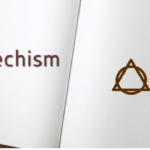The Parable of the Unforgiving Servant is recorded in Matthew 18:23-35.
Here it is in full (NIV):
“Therefore, the kingdom of heaven is like a king who wanted to settle accounts with his servants. As he began the settlement, a man who owed him ten thousand bags of gold was brought to him. Since he was not able to pay, the master ordered that he and his wife and his children and all that he had be sold to repay the debt.
“At this the servant fell on his knees before him. ‘Be patient with me,’ he begged, ‘and I will pay back everything.’ The servant’s master took pity on him, canceled the debt and let him go.
“But when that servant went out, he found one of his fellow servants who owed him a hundred silver coins. He grabbed him and began to choke him. ‘Pay back what you owe me!’ he demanded.
“His fellow servant fell to his knees and begged him, ‘Be patient with me, and I will pay it back.’
“But he refused. Instead, he went off and had the man thrown into prison until he could pay the debt. When the other servants saw what had happened, they were outraged and went and told their master everything that had happened.
“Then the master called the servant in. ‘You wicked servant,’ he said, ‘I canceled all that debt of yours because you begged me to. Shouldn’t you have had mercy on your fellow servant just as I had on you?’ In anger his master handed him over to the jailers to be tortured, until he should pay back all he owed.
“This is how my heavenly Father will treat each of you unless you forgive your brother or sister from your heart.”
The parable is not completely analogous to the atonement, because there is no mention of another person (like the king’s son) paying the debt for the servant, or the cost of that act. The king simply forgives the debt himself. And the parable only deals with one person, so it doesn’t address the universal aspect of the atonement. But still, I think we can gain insight here into how, when, and why God forgives us.
First, the King directly cancels the servant’s debt. It is a personal act. In this way, it is analogous to the satisfaction theory of atonement. What God did was a complete payment for sin that is individually appropriated. This aspect of the parable doesn’t align well with the governmental view of atonement, that some Arminians hold to.
Secondly, the cancellation of the debt was conditional in two ways. The king forgave the servant’s debt only after the servant begged for mercy (condition #1), and when the servant did not forgive someone else in need (condition #2), the king reinstated the debt. That doesn’t align with the Calvinistic view that the atonement is automatically applied, and can’t contain a “double jeopardy” clause – i.e. that a debt that has been paid can’t be reinstated(1). Apparently from God’s view, a debt can reinstated, even if it has previously been forgiven. God’s forgiveness is not based solely on the cancellation of a debt; it requires that we ask for it, and it requires that we forgive others who ask that of us.
So the atonement is both direct (a cancellation for our individual debts), and conditional (dependent on us asking and forgiving others). At least that is what this parable seems to imply.
—————————————————-
The original post may be found here.
(1) For a good explanation of the problems with the Calvinist double jeopardy view, see this article on the Arminian Perspectives blogs.





